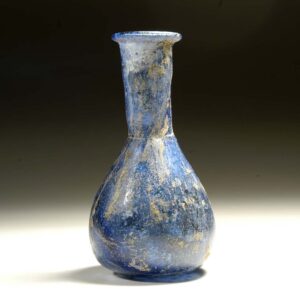This exceptional chalice – or ‘vase’ – is early 2nd millennium B.C.E. in date, and pertains to the Mesopotamian culture which lay between the two mighty rivers marking the boundaries of the Cradle of Civilization: the Tigris and the Euphrates. It is of an exceptionally refined and delicate shape, with an organic form flowing upwards from a narrow base to a fluted lip, exploiting the delicate banding of the stone. The walls are progressively thinned towards the lip. Stoneware items were extremely valuable in ancient Mesopotamia due to the enormous amount of work which went into their production and finishing: the basic shape was roughed out of a block of stone, but most of the work involved repeated polishing using sand as an abrasive, rubbed against the outline using leather or wooden tools.
The majority of the population would have had to contend with coarse ceramic vessels and would never have had access to a piece of this quality, particularly one so finely finished. Elite items belonged to the priestly class and to the rulers/gods of the palace estates which dominated this region, and it is uncertain as to which would have commissioned or owned this item. However, it is known that display pieces – for the pomp and circumstance involved in public ceremonies – were very figural and bold (i.e. Forest 1996: 123) in stark contrast to this item’s air of quiet refinement. It is thus possible that this is a personalized item, for a very powerful and wealthy potentate of the time.
Reference: Forest, J.D. 1996. Mesopotamie: L’apparition de l’etat:VIIIe-IIIe Millenaires. Editoriale Jaca Book, Milan.









